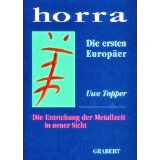
horra, the first Europeans
or
The Beginning of the Metal Age
English summary of a book published recently in German by Uwe Topper, Berlin (2003)

The invention of metal casting turned the development of mankind in a completely new direction. Up to now, historiography has more or less neglected this highly interesting moment. Although the results of archaeological excavations have brought to light many details, their compilation is still under way. Only an overall view will allow a better understanding of the development of Cultural Man, particularly with respect to our own high-level culture. The combination of archaeological findings with the legends of the ancient Mediterranean peoples as well as our own traditions provides amazing insights into the processes taking place during the transition from Stone Age to Metal Age in Eurasia.
The Early Fortresses
A classic example of the beginning of the Metal Age is the copper age settlement of Zambujal, Portugal, which has been excellently excavated and published by Portuguese and German archaeologists. This commercial post of the first metal traders looks like all the others of that era in the entire Mediterranean region. The basic commodities found there are evidence of far-reaching marine connections with similar trade centres. The raw materials originate from all over Europe, North Africa, and West Asia. It seems that the orientation towards navigation is a characteristic feature of the entire copper civilization. One may well conclude that the early smiths were good sailors and also exercised the political rule over the sea; they must have felt safe against enemy fleets or individual pirates.
The location of the fortresses on steep rocks in sea bays shows that the builders did not fear attacks from the sea side but certainly from the land side because the strongest walls were constructed on the saddle towards the land and often had a staggered shape. Likewise, the ingenious structure of the 'ward' of Zambujal is clearly directed against the mountains. Only in later stages, this manner of fortress construction became unnecessary as trade also brought peace in the surrounding land.
Archaeologists compare Zambujal with similar fortresses in the Northwest of Africa, on Mediterranean islands such as Sardinia (where they are called 'Nuraghes'), Sicily, and most of all in the Greek Aegean region. From this situation, an East-to-West spreading direction was derived. Following a well-known pattern and rejecting Kossinna, it is still assumed that the emergence of culture had its centre in Palestine or Asia Minor. A simple consideration makes this questionable: As the copper people had erected such sophisticated fortresses - often even presenting the same construction stages - in Greece and Palestine as well, they must have been forced to protect themselves from the indigenous population there, too, and are thereby recognisable as foreigners in the land. So where did they come from?
In searching for the homeland of the smith, we should proceed methodically in reverse to searching for the 'homeland' of a ceramic or arrowhead type. The origin of fortresses is not where many of them are found, instead the outermost border of that civilization is where the fortresses are built strongest. In Portugal as well as in Greece, we find an outer ring of those navigating merchants who spread the use of copper. The nearer we approach the homeland of the smiths, the weaker the fortresses have to be, and we will not find any fortresses at all in their own country. Defence-oriented architecture developed only in enemy countries and grew stronger in proportion to its distance from the place of origin. It seems that Zambujal with its four subsequent improvements is located at the outermost border of the copper civilization in a highly developed, initially peaceful region.
People
In the steppe where horse-breeders live, the art of fighting with bow and arrow was improved. Scythians and Numidians, Parthians and Thracians were the great archers of ancient times, all of them being steppe peoples from an ecological point of view. The Greek in their mountainous land and on the small islands were not enthusiastic about arrow-fighting but preferred to hire mercenaries as archers. Among them, the Kuretes were famous as the best archers, i.e. the descendants of those conquerors called KUR (Horr), being organized in guilds like the Rami of Tazeroualt in Morocco today with their mystics and their congregation houses. Among the numerous designations of archers, I have chosen the proper name of Horra as it is the most frequent and meaningful (Topper 1977). By this somewhat unusual orthography I want to underline the difference to local manifestations like Hurrians and Hurrites.
The arrow was also a means of expression making word and script superfluous. An example is the arrow message: If an arrow was sent to somebody, it meant war and a request for allegiance. Sending a broken arrow meant a declaration of war against an enemy. And, if a German threw an arrow towards his slave, that person was free.
Arrow poisons were widespread, but there existed also a code of honour which, for example, prohibited a Frank from using arrow poison against his tribal fellows. In hunting, poison was allowed in Germany until it was banned by law in the 16th century. The actual arrow poison of the early ages was carcass poison of rotten snake meat and human blood. This knowledge was passed on to us by the Greeks referring to the Scythians. It seems that experience led to the concoction of such poison. A hunter who reused an arrow which had been stuck in a decaying carcass for days will have realized the poisoning effect of it with astonishment.


Figures from left: Two types of arrowheads; wooden and stone figures on Kurgans - bronze figurine from Sardinia - rock carving from Sweden
The arrowhead was carefully manufactured from bone and horn and most of all from the hardest stone, flint (and obsidian). Better than ceramic remnants, arrowheads remained unchanged for long periods of time and allow us to perceive prehistoric settlements, wars, and wanderings. From the beginning, the main groups of the copper conquerors of the Iberian Peninsula used two different kinds of arrowheads: those of Almería (Spain) had legs while those of Tejo (Portugal) were concave (see illustration). As the 'Portuguese' arrowheads (without leg) are found in Almería as well, it can be assumed that there existed a connection in this direction such that the manufacturers of the legless arrowheads were suppliers to both settlement areas. This means trade relations for such a simple item over a distance of roughly one thousand km by sea, passing through the Straits of Gibraltar. These flint arrowheads were very cheap and durable, so they survived for a long time during the Metal Age confusing today's scientists because only copper and bronze arrowheads indicate the Metal Age.
Metal Trade
The trade which was introduced by the Horra for the first time in a continent-crossing dimension as is proved by archaeological findings, was also the steadiest institution of this large state. The cobalt used to dye Egyptian glass cups came from Schneeberg in the German Ore Mountains, buttons and jewellery made of North African ostrich egg shells lay in Portuguese tombs, remnants of silk gowns were found in nobility tombs in Southern Germany, for example at Hohmichele near Heuneburg on the Danube: a female corpse gown made of wool rep embroidered with Chinese silk threads; the woman lay next to her husband beneath a four-wheel carriage. Trade connected the outermost borders of the empire and is evidence of a 'Pax Hurritica' which must have been established by military force. In case of pure marine trade, a generally peaceful attitude of the coastal population - by no means a matter of course if one has in mind the later Greek situation - would have been sufficient, but transporting goods across large land areas definitely required a strict legislation plus the necessary supervisory measures in order to guarantee peace in the land. This includes roads, chains of message towers, marks (seals, badges) and military protection.
The Horric metal civilization from China to Egypt and from Scandinavia to the Sahara created a high-level culture which, within one or two generations, formed a completely new cultural image for mankind. It makes up the basis of our entire modern world civilization.
Trade in raw materials and its associated system of measures, fiscal economy emerging from it, and generally accepted legislation are the earliest indications of the inter-continental peace period of the first Metal Age. It seems that this civilization spread unusually fast in a peaceful way as trade requires peaceful co-operation. The most important contribution was copper which was mined in Andalusia, in the Ore Mountains, the Caucasian Mountains and in Cyprus and then alloyed with tin to obtain bronze. The latter was cast in accordance with standardized weight measures and mixing ratios thus becoming a high-quality article of exchange which was soon accepted by all Eurasian peoples.
The invention of metal casting established the 'smith' as the first independent profession. A person who mined, smelted, and processed ore could not allow for ploughing and harvesting, hunting and fishing. He had his tribal fellows supply him with foodstuffs as the products of his hands were of outstanding importance: due to their nature as weapons and tools, they made military and economic superiority possible. Trade which had emerged in this way soon developed beyond mere bartering, because whatever the smith wanted to buy for his products, e.g. foodstuffs and hides, wood for firing, and labour, was paid for by offering a valuable commodity to the customer, i.e. bronze axes which soon became a stable currency. At all excavations, such standardized bronze axes of equal size and weight were found. They had a stable inter-regional value and were even hoarded as their value did not diminish in the course of time. Museum exhibits are usually called 'votive axes'.
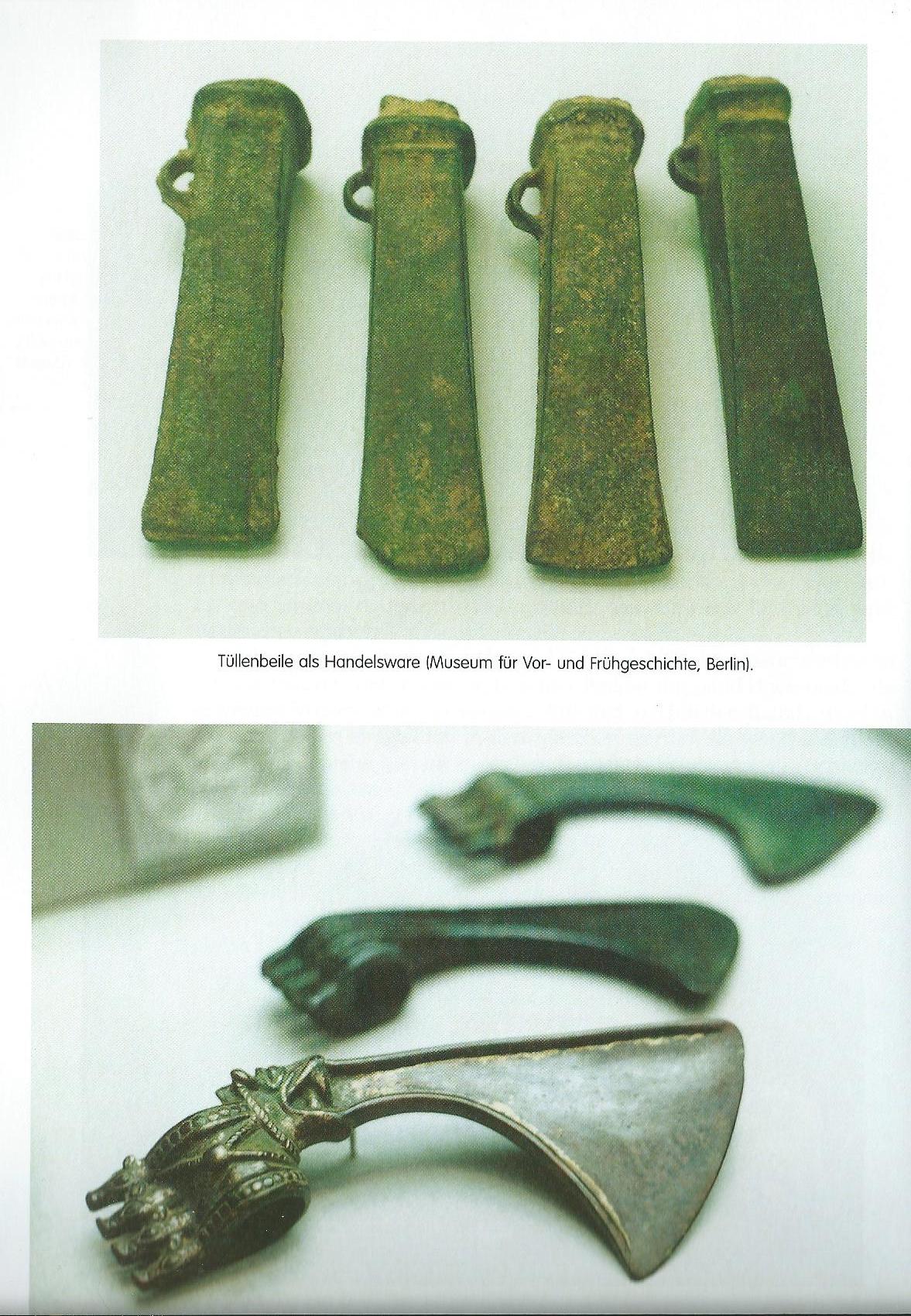
Bell-Beaker Culture
The first manifestations of organized metallurgy are associated with a certain ceramic type, the Bell-Beaker, named after its shape which resembles that of a bell. It is found all over Europe in well defined areas giving rise to suppose a small but powerful group of people in mostly foreign surroundings who embellished their life with this beaker and finally gave it to their dead in single graves. From all excavations it can be shown that the Bell-Beaker people were a minority of short and roundheaded features, wearing amber beads and V-hole buttons as well as the typical arm protection of the archer. And what is most important, they are the inventors of open cast moulds for copper and bronze. Remnants of the Bell-Beaker culture in zones of copper and tin ores like Cornwall and Devon consist of round huts, coloured faience beads and gold objects.
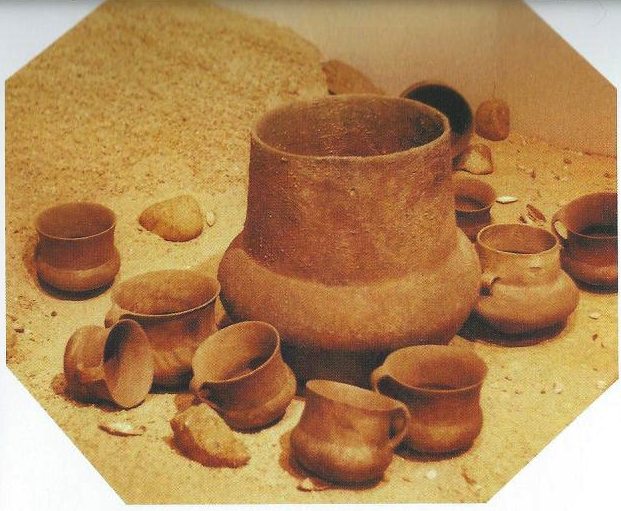
Bell beakers found in a tomb. Museum fur Vor- und Frühgeschichte Berlin
A map of their overall distribution leaves no doubt as to their activities: They settled along rivers like the Rhine and the Danube, spread along the sea coasts and also ventured inland, e.g. to the Spanish meseta. Trade must have been their second aim, while prospecting for ores and producing fine metal tools and weapons was their main goal. Nowhere did they form the sole human element but lived among megalith builders as well as alongside Neolithic farmers, archaeologically associated, too, with similar civilizations like those of the Corded Ware and the Battle-Axe.
The mentioned round huts traceable from black post holes in the ground might have been ritual structures used for gatherings, later developed into round towers which are the prototype of sanctuaries all over Europe. Their significance as multi-purpose buildings - stronghold, watch-tower and signal station as well as community centre - makes them the distinguishing mark of the early metal traders.
Most scientists class those settlements around the turn of the Third Millennium, which makes the introduction of bronze techniques a coeval event from China to Cornwall, Tuscany and Portugal.
Wine and Beer
Amazingly enough, the history of wine which is an important cultural asset in the civilized world of today, is limited to vague suggestions. Modern encyclopaedias present contradictory and completely obsolete information.
It can be sifted out of papers of archaeologists and specialists that the original cultivated vine grew at first in the North Iranian region, i.e. in the strip extending south of the Caspian Sea towards Afghanistan. However, there is a significant difference between the now widespread wild and the cultivated form of vine: The wild Vitis silvestris (spontanea) bears small grapes emerging from single-gender blossoms while the cultivated Vitis vinifera sativa bears large grapes emerging from hermaphroditic blossoms. It is still enigmatic how it was possible to cultivate the latter from the former.
Generally, oriental authors think that wine was imported from Armenia or the region east of it. At any rate, it is known that before the foundation of the Old Empire wine was a foreign commodity in Egypt originating from Asia rather than Ethiopia where there exists cultivated vine that has reverted to the wild state. It seems that grapes were always pressed in the way still carried out by simple wine growers, namely by treading it in stone or wooden troughs. The grapes were pressed out in sacks with several men turning two wooden bars. The ancient wine of Egypt, which was always red wine, was filled into amphorae.
In other words: Here we find already the fully developed wine culture which has survived until today from Portugal to the Hindukush. While with respect to the peasants in the Porto region or the Kalash in the Hindukush (here at least during ritual feasts such as remembrance ceremonies or winter solstice, c.f. Topper 1977) the whole community including women and children drink wine, it was reserved to the nobility and the priests in Egypt (the ordinary people drank only beer). This fact also indicates that wine was an 'imported good' in Egypt.
Did the early copper people drink beer already?
At that time, huge amounts of grain were grown, most of all barley and wheat. But the bread of which remnants are sometimes found was certainly of inferior quality. The flour was badly milled and even worse screened thus being loaded with impurities, mainly sand. This suggests that bread was not held in high esteem. In Zambujal, pulp made of pounded grain was also found while of course no beer was ever traced. Nothing had been left in the Bell-Beakers. 'Nothing' is also an indication: only a liquid dries out completely.
By the way, much refined methods of investigation recently revealed that in some Bell-Beakers various kinds of pollen were preserved which suggests that the beer was mixed with herbs.
Although Bell-Beakers have been found in a very large region their number is limited and restricted to certain locations. So, they did not represent a 'general fashion', but something particular, a mark. In Zambujal, Bell-Beakers amount to only 0.8% of all broken pottery found which still means 160,000 pieces. They were found in certain strata only, most of all in stratum 4, and only in the innermost buildings of the settlement, mostly in the ward and the tombs.
All this leads to the conclusion that the elite, namely the caste of smiths, drank beer. Men who permanently work near the fire such as a smith at his forge, are sweating and always thirsty. And those who additionally inhale toxic metal vapours have to compensate for the loss by drinking lots of liquid to flush the kidneys. For this purpose, water is not very apt. Beer is the ideal beverage for such a heavy labourer. In the Ruhr region, the steel and coal producing centre of Germany, more beer is drunk than anywhere else.
Identification Marks
Strange amulets, namely small flat tablets of cut slate provided with carvings, are part of the significant inventory found in the early Metal Age settlements in the West of the Iberian Peninsula. Generally, they are attributed to the Bell-Beaker people because they appear together with Bell-Beaker ceramics. In Portugal, the immediate area where slate tablets were found extends from the river Tejo to the river Guadiana, while similar tablets have been found in Almería (Spain) and in France (near Châlon-sur-Saône and in the department Hérault); they are likewise found - although slightly differing in shape and made of different materials - from the Sahara via the Greek islands to Cyprus and the Orient.
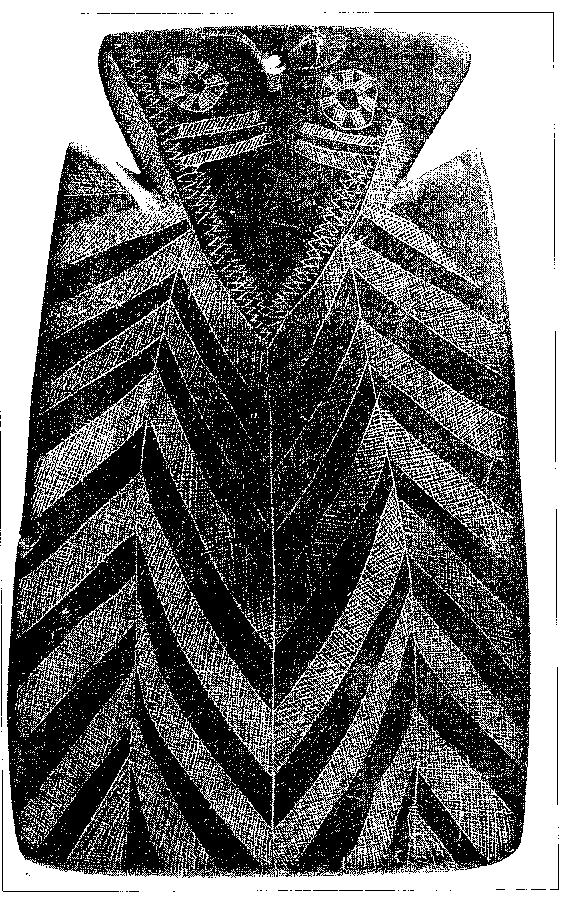
An evaluation of the many thousands of small slate tablets in Portuguese museums plus the associated literature shows that there is a certain similarity with the wooden stelae found almost world-wide on tombs, so that they should be considered as belonging to the same spiritual and ornamental background. Generally, the schist tablets are smaller than a hand, being smooth and flat on the front ornamented with carved lines while the back is curved and rarely provided with carvings. Most of them have one, some have two holes at the upper end which might be interpreted as eyes. It seems that the interpretation as eyes or human figures is wrong as in fact the tablets appear to be abstract. Besides, the borehole has a V-shaped cross-section just as in the case of the garment buttons of this cultural group which are also regarded as an identifiers of the early metal traders.
It has not yet been discovered what the slate tablets actually mean. As they hardly present any traces of abrasion by use, it is not probable that they were worn as adornments. Could they have been the first personal identification objects, a kind of identification card proving the membership in the elite, i.e. the smiths?
Domestic Animals: Horse, Goat, and Sheep
According to our scholastic historiography, the taming of horses is directly linked with the emergence of the 'Indo-Europeans'. The first horse keepers and the 'early Indo-Europeans' are often seen as identical. As our own culture is tightly linked to this problem - in fact, the European culture was the highest developed horse culture on earth - there exists a great deal of research and literature output at our universities on this subject. In most cases, the inquiry is regarded as being completely solved. Although the basic facts and most of the details are known, so far no summarising synthesis has been presented which would apply to many other fields of knowledge as well. There had been intense research, but the generalising overview which is the actual fruit of research work has been omitted.
When and where have horses been tamed first?
fig.: Bronze snaffle of a horse
If one does not take into account the enormous dimension of the Eurasian region, the question can be answered geographically: The domestic horse was bred somewhere between the Danube river and the Altai mountains along the steppe belt of the 50th parallel Northern Latitude. Wild horses were chased as early as in the so-called Palaeolithic Era in the entire region between China and Iberia as is proved by many retrieved bones, but taming succeeded much later because the inborn escape reflex and the zest for freedom of the horse are much stronger than those of the aurochs or the reindeer. Chasing horses developed into tending the herd gradually with man ensuring the continued existence of the best animals by prudent selection. The horse-tender followed the herds through the change of seasons thus becoming the lifemate and finally the master of the horses.
The beginning of the spreading of tamed horses coincides in time with the spreading of copper casting; both events happened suddenly at the same moment, if we consider one or two generations as a 'moment' from a historical viewpoint. This invention spread like a huge wave over the whole of Europe, from Tripolye in Ukraine to Zambujal in Portugal. For conventional chronology, 2300 to 2200 B.C. is given, whereby the Eastern locations of findings are regarded as slightly older than the Western ones. Apart from Podolia, sometimes Armenia and even Mesopotamia ('Sumer') are designated as region of origin of this horse-metal culture. While this is possible for Armenia because it presumably was the first colonisation region of the horse keepers, it is improbable with respect to 'Sumer'. The so called Sumerians did not originate in a vast river valley but came from mountains to the North and East of Mesopotamia. The Altaic languages which were spoken north of the Caucasian and the Kophet mountains, i.e. in the 'horse belt', are regarded as the closest relatives of the 'Sumerian' language.
In all archaeological excavations, goat bones are found in connection with the early metal culture. Goat and smith belong together.
In 1882, about 20 million goats were still kept in Europe, while they are nowadays restricted to some isolated mountainous regions. Therefore, we are unable to imagine the former great significance of this animal which perhaps was the first domestic animal of mankind. The Bezoar goat (Capra aegagrus) is considered as the wild form (according to F. Zeuner), which lived in a very large area from Crete via Anatolia and Iran to the Indus valley. The centre seems to have been the Kophet mountains at the Northern edge of Iran. A second wild goat species called Markhor (Capra falconeri) lives there which may as well have been the origin of some domestic goat races such as the variant in Turkestan and the Dard region which have nearly upright horns.
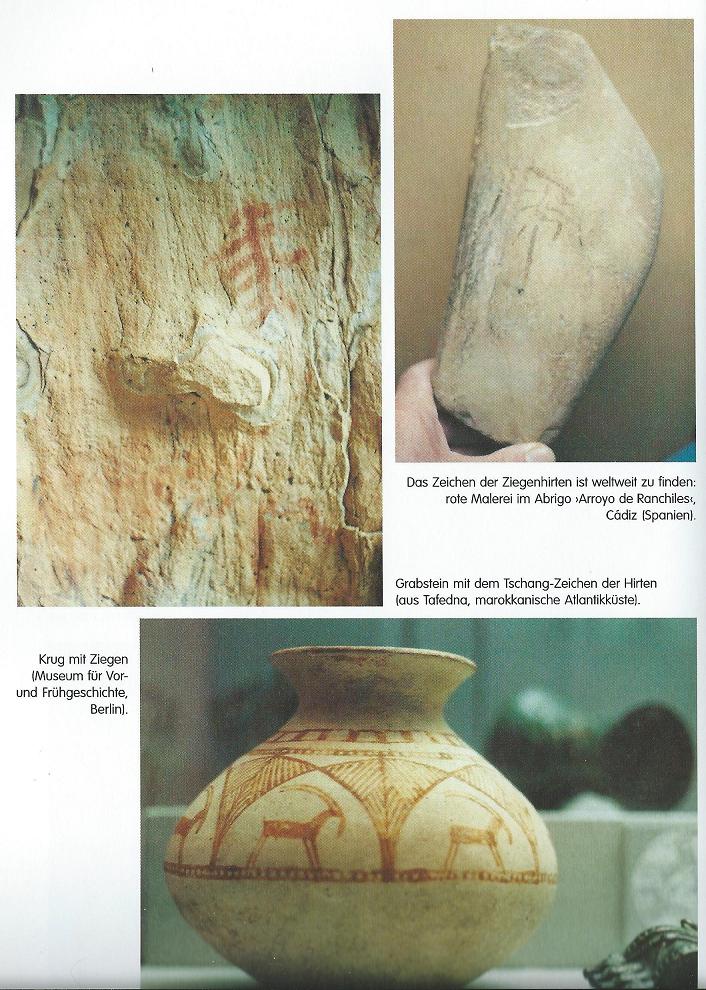
Hardly later than the goat, the other 'mountain animal', the sheep, has been domesticated. In Europe, it has played a larger role than the goat in historical times, although it is less profitable and needs better pastures. Experience shows that its tending is easier. Sheep, too, belong directly to the economic system of the early smiths.
For both 'mountain animals' (goat and sheep), more or less the same origin is considered, the lands from Eastern Anatolia to the Indus river and to Central Asia with the centre being Northern Iran, and the period for both being the so-called Mesolithic Era. In historical times, goats and sheep were kept side by side; both species complement each other, and a mixture of goat hair and sheep wool provides a waterproof fabric most suitable for making the large tents of nomads. Classical Chinese texts do not use different expressions for sheep or goat; both are simply called 'mountain animal' which also underlines the close interconnection.
Lance and shield are the preferred armament of the goat herdsman. The lance is stylized as the herdsman's rod which becomes the mystic symbol of the goat herdsman as such. The rod of the shepherd, being rolled in like the horns of a moorland sheep, is still used by Catholic bishops nowadays as a symbol of their herdsman's function.
The shield was developed to become a mark of property, represented in innumerable rock drawings from Cashmere to the High Atlas. The shield was made of goat skin, called skutos = shield in Greek, related also to the Latin word cutis = skin. The oldest fairytales about 'goat men' indicate the region of the mountains between Iran and Pamir, the mythical Mashu mountain in the Gilgamesh epic.
The signs of the goat herdsmen formed the basis for the first standardized script signs understood by everybody. They have been preserved in more clarity in the early Chinese script. From there, the pictograms from the Hindukush to the Canary Islands can be interpreted and some of them even read phonetically.
Linguistic Development
After the Horra had crossed the Caucasian mountains and invaded the Orient from Mesopotamia to the Mediterranean Sea, they established a new capital near the Ararat. From there, they ruled over their new territories. At first, Hurritic was the official language until it was replaced by Akkadian. For the purpose of maintaining power by military means, many auxiliaries were needed, and it became evident that the Caucasian peoples were the most suitable for this task. These Ar-meni (Arian men, mountain people) were melted into a warrior caste and detached to the administrative centres, i.e. the big cities. They were the first soldiers in the actual sense of the word, namely professional warriors receiving pay. Their language has survived for a long time in the regions ruled by them on behalf of the Horra as a kind of Armenian or 'Indo-European', in fact a Koine like all administrative or military languages, an 'Urdu' (i.e. order, army, camp).
One of the best examples are the Mitanni among whom the Arian share of personal and god names within the official Hurritic language is very conspicuous. One thinks immediately of a foreign vassal people executing the administration of the subordinates on behalf of the Great Khan of the Horra.
We find a similar development with regard to the Hittites who were assigned by the (nowadays) so-called Hatti and who introduced their new language. There are other examples for Central Europe which unfortunately are not supported by literary texts but can be derived from topographical and river names, and from myths.
During the intervention of Arian warriors into the various regions, several dialects of this Koine emerged which always include the same basic elements. They had on the one hand developed from previous spoken forms and on the other hand undergone continuous adaptation due to trade and inter-regional political activities. This is what linguists call 'proto-Indo-European'. The original Horric language is related to this Hurric or Hurritic language although slightly differing from them by its vaster application.
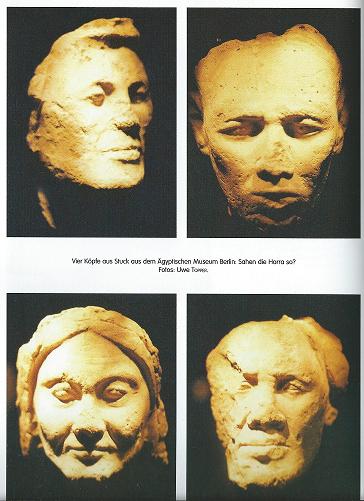
Four faces in stucco from Old Egypt (Museum Berlin). They rather look Central-Asian than Egyptian.
Uniform Ideology
The ideology spread by the Horra can hardly be proved archaeologically except by listing the missing elements which are registered in other cultures as religious artefacts. Instead of the temple buildings, they only built cult tents, and instead of the idols common elsewhere we find a lack of images. It was perhaps for one long century that this religion-denying state was forced by law upon the oppressed, but the gradually re-emerging usual cult objects show that this law was soon undermined and evaded. The image-free belief in a unique God which the Horra had propagated manifested itself in later times only rarely as a side branch, occurring intermittently, e.g. in the Jewish scripts of the prophets or in Buddha's sermons.
The original ideology of the Horra - as far as it can be indirectly reconstructed - may be described as Shamanism. Worship was not directed to a God or gods but to manifold spirits; this was also the point of origin for alchemy and medicine.
The Blocksberg legend (located in the Harz mountains of Northern Germany) reminds us of the strong relationship between the female shaman (or witch) and the male goat. This image occurs also on cylinder seals of the Indus and Mesopotamian cultures: a 'goddess' standing next to a male goat. In Germany, too, a piece was found indicating such a group; the wooden goat figure was found in a place called Schmiden in Swabia.
A very significant feature of the Horra ideology is the goat cult and its esoteric mysticism which extends far beyond the limits of purposeful herdsmen's cults. Its far reaching evolutions are as significant as the Dionysos cult and the crucifixion of Christ, and its ideas have steadily survived in carnival habits and monastic order rules. The spiritualisation of the mysteries with their secret language, monastic type of regime and drastic requisitions of purity developed by the men's leagues on the high alpine pastures corresponds with the deep piety of a sect or a fraternal community; their visions provoked by juniper smoke are the primeval notions of prophetical pronouncement.
It is amazing to see how many elements of goat herdsmen's mysticism have survived in the classic cults and even in the Christian religion up to modern (Freudian) analysis of dreams. Is this related with the economic power of that professional group? Or is it rather the reminiscence of an early historical mission which has spread its basic ideas?
History of Technology
The study of certain technological achievements gave rise to the idea that the Hyksos ruling over Egypt are the early Eurasian smiths who must be identical with the builders of the Old Empire pyramids. In fact, no mathematical records exist in the Nile valley before the Hyksos era, and without such tools it is impossible to construct large buildings such as the pyramids, just like it is impossible to cut and polish diorite or malachite without steel. It is also known that women played an outstanding role in Egypt which certainly has nothing to do with the Arian (in this case Persian) conquests but is genuinely Horric in origin.
In continuation of John Dayton (1978), who also pilloried "the idée fixe of the superiority of the civilization of the Fertile Crescent" (p. 76), Heinsohn and Illig (1990) examined the glass production in Egypt. Glass, especially cobalt-blue glass, is an achievement accomplished by the Hyksos and appears 'simultaneously' in Mycenae, Nuzi, at the Phoenician coast and in the Hallstatt period of Europe. Cobalt occurs in very few locations of the Old World, e.g. in Anarak in Iran, in Morocco and in Schneeberg (German Ore Mountains). Due to its impurities, the cobalt used in ancient times to dye glass can definitely be traced back to the Ore Mountains where it occurred as a waste product of the silver-melting process. So, wherever we come across the blue glass beads - be it in Amarna on the Nile or in Israel's Bet Shean, in Mesopotamia or at the Northern edge of the Alps - we have to perceive the chronological and cultural relationship which I called Horra rule. Indeed, Bohemia and the Ore Mountains were the domain of the Bell-Beaker people. And the earliest - always blue - glass bottles were not blown but produced in a casting process imitating metal casting.
In her first book, Sigrid Hunke (1955) developed principally new ideas about the Hurrites based on archaeological discoveries in Anatolia. Since then, only few efforts have been made to continue investigation into the spiritual assets of this cultural group. The author (1977) once again lifted the Horra into the centre of considerations as regards the assessments of the early Metal Age. In his recently published book he presents a comprehensive survey of this cultural event which might induce further research work. The ideas expressed therein give a new impetus to a novel investigation of those astonishing cultural changes thus reviving Spengler's (1966) posthumously published notes which were and still are insufficiently used by scholars.
References
Blöss, C. und Niemitz, H.-U. (1997): C14-Crash. Das Ende der Illusion, mit C14 und Dendrochronologie datieren zu können (Gräfelfing)
Dayton, John (1978): Minerals, Metals, Glazing and Man (London)
Heinsohn, Gunnar (1984): Privateigentum, Patriarchat, Geldwirtschaft (Frankfurt/M.)
(1988): Die Sumerer gab es nicht (Frankfurt/M.)
Heinsohn, G. und Illig, H. (1990): Wann lebten die Pharaonen? (Frankfurt/M)
Heyerdahl, Thor (1978): Wege übers Meer. Völkerwanderungen in der Frühzeit (München)
Hunke, Sigrid (1955): Am Anfang waren Mann und Frau (2.Aufl. Bonn, 1980)
Sangmeister, Edward (1995): Zambujal. Kupferfunde (Madrider Beiträge 5, Teil 3; Mainz)
Sangmeister, Edward u. Schubart, Hermanfrid (1981): Zambujal, die Grabungen von 1964-1973 (Madrider Beiträge Bd. 5, Mainz)
Schildmann, Kurt (1994): Die Indusschrift entziffert! in: Efodon-Synesis Nr.5 (Wessobrunn)
Spengler, Oswald (1966): Frühzeit der Weltgeschichte (postum, München)
Topper, Uwe : (1977): Das Erbe der Giganten (Olten)
(1977 b): Beobachtungen zur Kultur der Kalash (Hindukush) in: Zeitschrift für Ethnologie Bd. 102, 216-296 (Braunschweig)
(2003): Horra. Die ersten Europäer (Tübingen)
Topper, Uwe u. Uta (1988): Arte rupestre en la provincia de Cádiz (Cádiz/Spanien)
Zeuner, Frederick (1963): Geschichte der Haustiere (London; dtsch. München 1967)
This article was published as: "The Beginning of the Metal Age : horra, the first Europeans", in: migration and diffusion, vol. 4/ no. 14 (Vienna 2003) ISSN 1563-440X (about 20 pp)